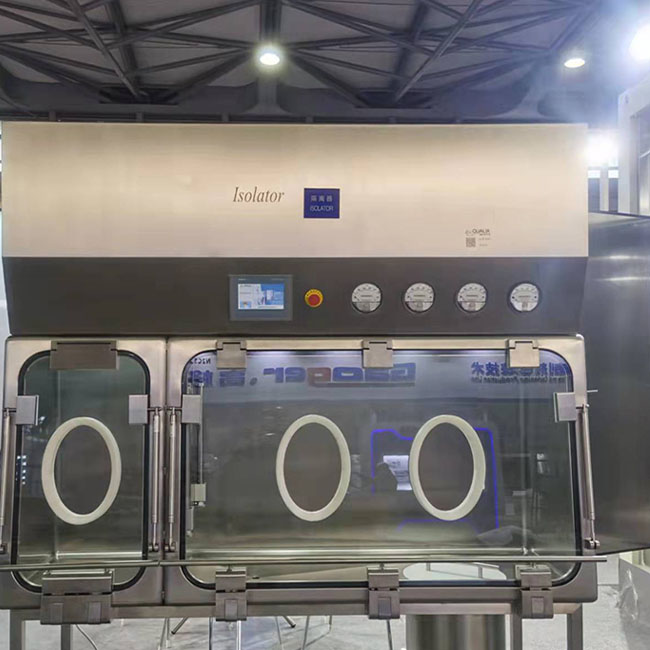
In high-precision, demanding industries such as life sciences, pharmaceuticals, biotechnology, and medical device manufacturing, a sterile environment is the cornerstone of product quality and safety. With the advancement of science and technology and the continuous improvement of industry standards, Sterile Isolator/Sterile Test Isolator, as the key equipment of modern laboratories and production workshops, is becoming the backbone of the pure line of defense of the life science and health industry with its unique advantages and characteristics.
What is the Aseptic Isolator/ Sterility Test Isolators?
The Aseptic Isolator/Sterility Test Isolator is an enclosed isolation system developed and manufactured independently by Shanghai Qualia. It is specifically designed for Occupational Exposure Band (OEB) production protection and for sterile production, experiments, and biological safety protection. This innovative isolation system plays a crucial role in maintaining a sterile environment for various applications including aseptic experiments, biological experiments, production involving sensitizing/toxic substances, and the breeding of Specific Pathogen Free (SPF) grade experimental animals. Its primary function is to ensure that processes carried out within its confines are free from contamination, providing an aseptic environment that meets high standards of sterility and safety.
The Aseptic Isolator / Sterility Test Isolators provide a sterile environment for aseptic and aseptic compounding, designed in compliance with USP <797> and <800> standards. These isolators are preconfigured at the factory to operate in either positive or negative pressure modes, and are designed to utilize either recirculating or total exhaust airflow schemes.
Ultimate sterility assurance
The core advantage of a aseptic isolator is its ability to provide a completely enclosed, aseptic operating space isolated from the outside environment. Through high-efficiency filtration systems, such as HEPA filters, it effectively removes particulates, bacteria, viruses and other pollutants from the air, ensuring that the internal environment meets the highest cleanliness level specified in ISO 14644-1. This highly sterile environment is essential for key aspects such as cell culture, microbial research, sterile preparation production, and drug sterility testing, effectively avoiding cross-contamination, ensuring the accuracy of experimental results and the sterility of products.
Flexible operating design
The modular design of the aseptic isolator allows it to be customized for different experiments or production needs, such as resizing, adding special interfaces, or integrating automation equipment. Its user-friendly interface is equipped with interactive methods such as a viewing window, glove box or robot arm, which not only ensures the safety of the operator, but also improves the work efficiency. In addition, some high-end sterility test isolators also integrate online monitoring and control systems, which can monitor internal environmental parameters such as temperature, humidity, pressure difference and microbial contamination in real time to ensure the continuous stability and compliance of the operating environment.
Environmental protection and energy saving
With the increasing awareness of environmental protection around the world, aseptic isolators are also designed with more attention to energy saving and environmental protection. Adopt advanced energy efficiency management system to optimize energy use and reduce energy consumption. At the same time, some equipment also has the function of exhaust gas treatment, which purifies the harmful gases generated during operation to ensure that the emission meets environmental protection standards, reflecting the respect and responsibility for the environment.
Features of QUALIA's Negative Pressure Isolators
1.Biosafty/OEB isolators with high airtightness meeting pressure decay test requirements: Sustains +1000pa leakage under 20 min remaining above +750pa.
2.Stainless steel construction with full welding, fine detail finish, and inner weld surface roughness achieving 0.3um.
3.Customizable exhaust systems as per usage needs, options for bag-in bag-out processes, and selectable on-site decontamination/scanning devices.
4.to both sterile A-class and biosafety standards, adapting to usage requirements.
5.Individual control modules for ease of electrical maintenance, reducing time, effort, and maintenance costs.
6.Choice of Siemens industrial PC or touchscreen for operation and parameter monitoring. Audit trails, online e-signatures, and data communication/storage/printing compliant with CFR21, with the option for integration into a BMS for data storage and printing.
7.Large isolators with modular design allowing for on-site assembly, circumventing unnecessary transport difficulties.
8.All isolators can be equipped with built-in VHP generators to ensure operational safety and sterilization reliability. The VHP generator shares a control system with the isolator for streamlined validation and maintenance, enhancing sterilization control traceability.
9.Option to include real-time monitoring of the inner chamber's airtightness in the control system, with alerts for exceeding preset values for enhanced safety.
10.Automatic activation of the protection system to maintain negative pressure and prevent leaks into the environment in case of emergency failures like door seal or glove damage.
11.Ensures door safety during use, featuring additional protective handles.
12.Provides professional validation documents and services, allowing for controlled validation process at each stage.
Conclusion
Sterile isolators have become indispensable and important equipment in the field of life sciences due to their excellent sterility assurance capabilities, flexible operation design, and environmental protection and energy saving. It not only improves the efficiency and quality of scientific research and production, but also builds a solid line of defense to protect human health and safety. With the continuous advancement and innovation of technology, sterile isolators will play a more important role in the future and promote the life science industry to a higher level.









